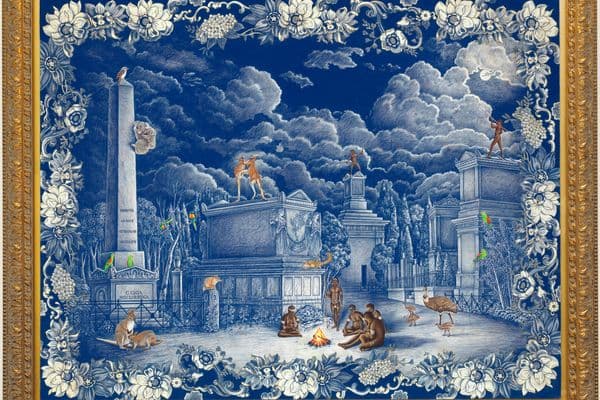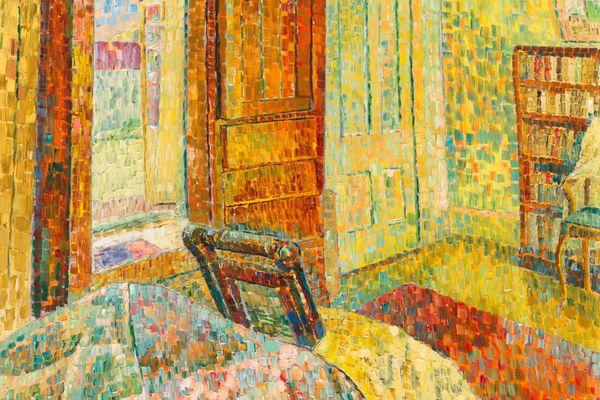Jeffrey Smart
Media Kit

Jeffrey Smart, The construction fence, 1978, TarraWarra Museum of Art, Healesville, Gift of Eva Besen and Marc Besen AO 2001 © The Estate of Jeffrey Smart.
Key information
The National Gallery has developed these online media kits for media usage only.
By downloading these images you are agreeing to the following:
Images are used exclusively by media, and only for purposes of publicity of the National Gallery of Australia, falling under the special exemptions of Fair dealing for purpose of reporting news or Fair dealing for purpose of criticism or review, as set out in the Copyright Act 1968; images must be accompanied by the provided caption; reproduction of images must respect the artist’s moral rights i.e., no cropping or overprinting on images.
Contact
For enquiries, please contact
Jessica Barnes
Communications Officer
T +61 2 6240 6431
E media@nga.gov.au
‘Suddenly I will see something that seizes me — a shape, a combination of shapes, a play of light or shadows, and I send up a prayer because I know I have seen a picture.’
- JEFFREY SMART
One of Australia’s most celebrated artists, Jeffrey Smart sought inspiration from the world around him — looking to the environment of urban and industrial modernity — which he transformed through his imaginative sense of theatre and intimate understanding of geometry and composition.
Jeffrey Smart is not a retrospective but rather considers Smart’s artistic legacy thematically. Beginning with his significant foundational years in Adelaide through to his final years in Tuscany, themes include theatre of the real and the uncanny, surveillance, abstraction and figuration, portraiture, and art about art.
Exhibition highlights include early works such as Robe and the small, surreal Strange Street, his last major painting Labyrinth, the dreamlike Jacob descending, the playfully referential Corrugated Gioconda, and several portraits, such as Portrait of Margaret Olley at the Louvre Museum, Portrait of Clive James, Portrait of David Malouf, and Self-Portrait, Procida.
These potent and intriguing images have become emblematic of the 20th and 21st century urban experience.
Download images

Jeffrey Smart, Wallaroo, 1951, National Gallery of Australia, Canberra, purchased 1959, © The Estate of Jeffrey Smart.

Jeffrey Smart, Self portrait, Procida, 1950-51, National Gallery of Australia, Canberra, purchased 2016, © The Estate of Jeffrey Smart.

Jeffrey Smart, On the roof, Taylor Square, 1961, National Gallery of Australia, Canberra, purchased 1969, © The Estate of Jeffrey Smart.

Jeffrey Smart, Waiting for the train, 1969-70, National Gallery of Australia, Canberra, purchased 1969, gift of Alcoa World Alumina Australia 2005, © The Estate of Jeffrey Smart.

Jeffrey Smart, Holiday, 1971, private collection, courtesy of Menzies Art Brands © The Estate of
Jeffrey Smart.

Jeffrey Smart, Corrugated Gioconda, 1976, National Gallery of Australia, Canberra, purchased 1976, © The Estate of Jeffrey Smart.
///national-gallery-of-australia/media/dd/images/351115_USYDAC_UA2011.26_-_Large_Viewing_JPEG_4200px_Morning_at_Savona.jpg)
Jeffrey Smart, Morning at Savona, 1976, University Art Collection, Chau Chak Wing Museum, University of Sydney, Donated through the Alan Richard Renshaw Bequest 1976, © The Estate of Jeffrey Smart.

Jeffrey Smart, The construction fence, 1978, TarraWarra Museum of Art, Healesville, Gift of Eva Besen and Marc Besen AO 2001 © The Estate of Jeffrey Smart.

Jeffrey Smart, The plastic tube, 1980, private collection, courtesy Gallery Sally Dan-Cuthbert, Sydney © The Estate of Jeffrey Smart.

Jeffrey Smart, Labyrinth, 2011, National Gallery of Australia, Canberra, purchased with the assistance of the Margaret Olley Art Trust and Mr Philip Bacon AM in honour of Dr Ron Radford AM, Director of the National Gallery of Australia 2004-14, 2014 100 Works for 100 Years, © The Estate of Jeffrey Smart.

Installation of Jeffrey Smart's Plastic Tubes, 1980, at the National Gallery, Canberra, 2021.

Installation view of Jeffrey Smart, National Gallery of Australia, Canberra, 2021

Installation view of Jeffrey Smart, National Gallery of Australia, Canberra, 2021

Installation view of Jeffrey Smart, National Gallery of Australia, Canberra, 2021

Installation view of Jeffrey Smart, National Gallery of Australia, Canberra, 2021

Installation view of Jeffrey Smart, National Gallery of Australia, Canberra, 2021

Installation view of Jeffrey Smart, National Gallery of Australia, Canberra, 2021

Installation view of Jeffrey Smart, National Gallery of Australia, Canberra, 2021

Installation view of Jeffrey Smart, National Gallery of Australia, Canberra, 2021

Installation view of Jeffrey Smart, National Gallery of Australia, Canberra, 2021

Installation view of Jeffrey Smart, National Gallery of Australia, Canberra, 2021
///national-gallery-of-australia/media/dd/images/1000px_jeffrey943.30258d7.jpg)
Jeffrey Smart in his studio in Arezzo, Italy, 2011, while painting his last work Labyrinth. Image © Rob Palmer.

Co-curators of Jeffrey Smart (left to right) Dr Rebecca Edwards and Dr Deborah Hart.

(from left) Sid and Fiona Myer Curator of Ceramics and Design Rebecca Edwards, Director Nick Mitzevich and Henry Dalrymple Head of Australian Art Deborah Hart are pictured with Jeffrey Smart’s Labyrinth (left) and Waiting for the train (right).

Jeffrey Smart signage at the National Gallery of Australia, Canberra, 2021.











